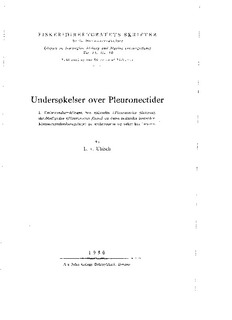| dc.description.abstract | The paper starts by describing the normal embryonic development
of the plaice (Pleuronectes platessa) and the flounder (Pleuronectes
flesus) up to the formation of the embryo. The development is divided
into fourteen stages, a schedule of which is given.
The embryonic development of the two species is exactly similar,
the only difference being the comparative size of their eggs, blastodiscs
and cells. The size proportion between the two species is however not
constant, but in the course of the development changes in favour of the
flounder. The size proportion between the blastodiscs of the plaice and
the flounder which at first is approximately 2:l will thus change to
about 3:2 later in the development.
The rate of development of the flounder is greater than that of the
plaice. The flounder-embryo with optic vescles is formed after about 98
hours, the plaice embryo after about 122 hours. This lead increases
during the later stages of the development, since the hatching of the
flounder eggs occurs 6-8 days earlier than that of the plaice eggs.
The organological and histological development of both the hybrid
forms does not differ from that of the parents. But the size of the blastodisc
and the cells and the rate of development until the formation of the
embryo are in complete accordance with the mother-form. Later the
influence of the father on the rate of development becomes noticeable,
the hybrid plaice ♀ x flounder ♂ will now develop faster than the
mother but slower than the father, and the hybrid flounder ♀ x plaice
♂ slower than the mother but faster than the father. Under the temperature
-conditions prevailing during this experiment both the hybrid
forms were hatched after a period of 12 days, the flounder after 9 days
and the plaice after 15-16 days.
Neasurements of nuclei from plaice, flounder and their reciprocal
hybrids gave the following results: The nuclear size decreases during the
development in all four forms. In the first part of the development until
stage 8 the author found especially in the plaice and the hybrid plaice ♀
flounder ♂ great variations in the nuclear size of different individuals
from the same stage. These individual variations suggest complications
due to a haploid or polyploid development. But probably all of these
abnormal eggs die before gastrulation, only normal ones developing
further.
In almost all stages the plaice has a greater nuclear size than the
flounder, a fact which according to studies of equatorial plates, is a
consequence not of a greater number, but rather of a greater size of the
plaice chromosomes.
One should expect the nuclear size of the hybrids to be intermediate
between those of the parents, but the curves do not give a clear confirmation
of this probably on account of an insufficient number of measurements.
But the curves do show that in the latest stages the nuclear size
of the hybrids seems to approach that of the flounder. This may indicate
that some of the father chromosomes of the hybrids are ejected.
Since the cellsize of the hybrids corresponds with that of the mother,
but the nuclear size differs from the nuclear size of both the mother and
the father, the nucleus-plasma-relation of the hybrids and their parents
is different.
Until the age of 49-56 days after the fecundation the growth of the
fry shows great individual variations. The author did not succeed in
breeding the flounder and the hybrid flounder ♀ x plaice ♂, therefore
the following growth-dates only concern the plaice and the hybrid plaice
♀ x flounder ♂. The mean length of 355 plaices was 16.58 mm ± 0.6,
whereas 114 and 142 hybrids showed a mean length of respectively
17.88 mm ± 0.9 and 16.08 mm ± 0.7. The results indicate that the
growth rate of the hybrid plaice ♀ x flounder ♂ does not differ from
that of the plaice in the first months of their lives. | |
